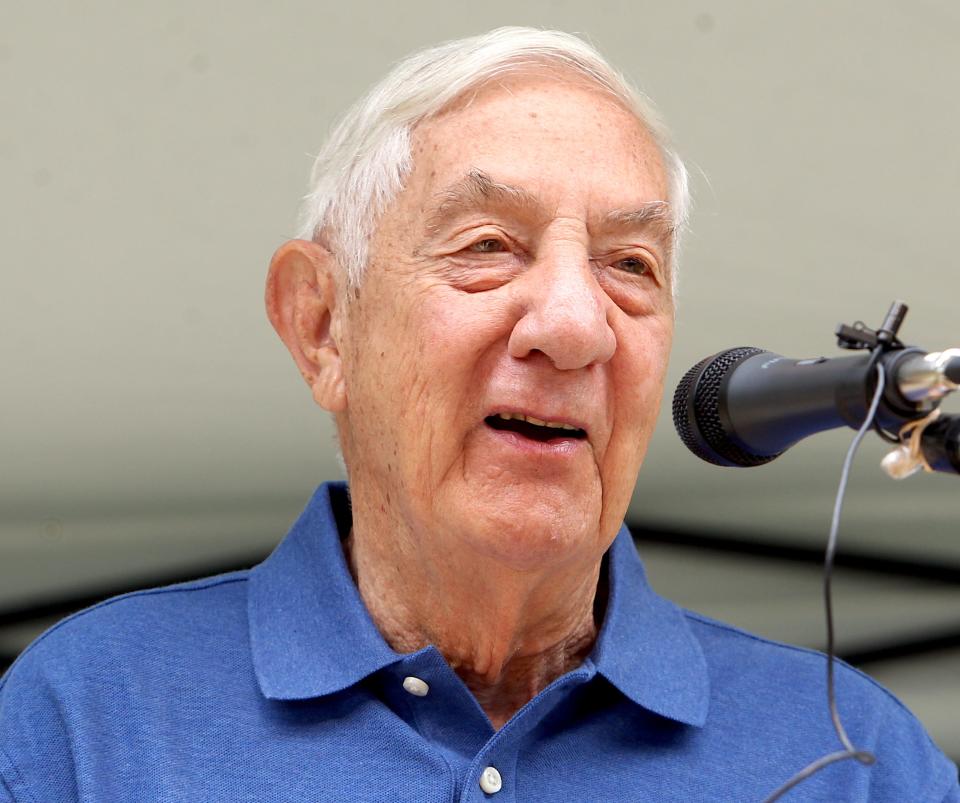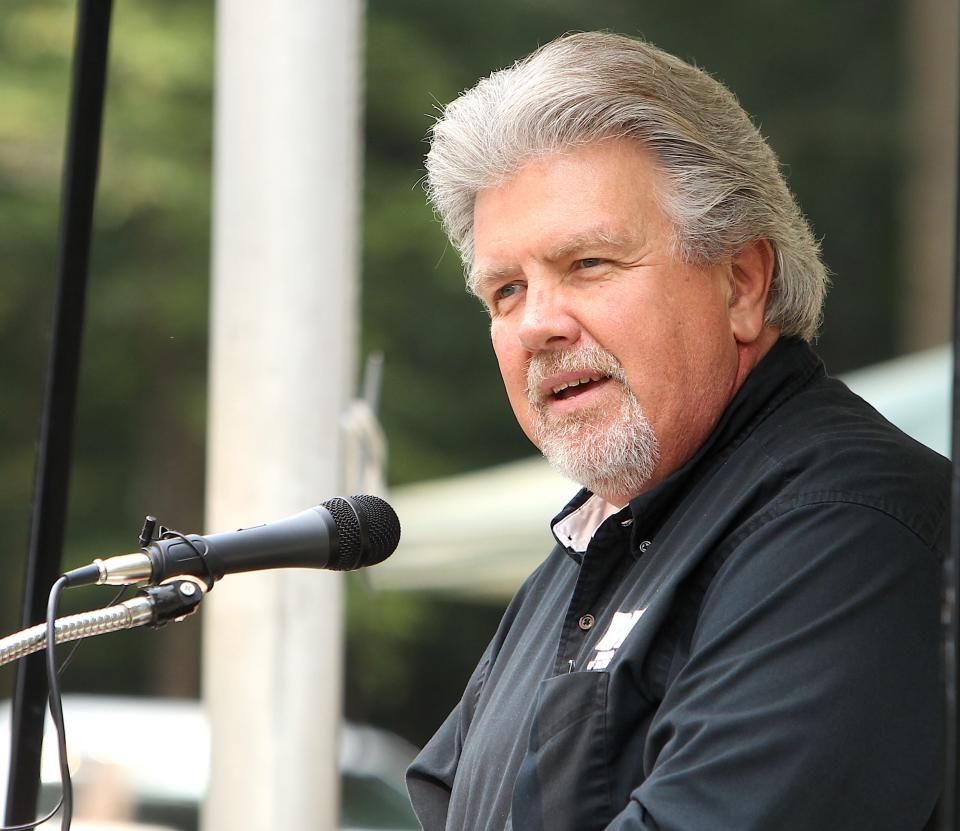Grissom Memorial at Spring Mill State Park celebrates 50th anniversary
- Oops!Something went wrong.Please try again later.
- Oops!Something went wrong.Please try again later.
MITCHELL — A large gathering at Spring Mill State Park Wednesday morning marked the 50th anniversary of the Virgil I. "Gus" Grissom Memorial and the 60th anniversary of Grissom's first space flight on July 21, 1961, in the Liberty Bell 7.
Most of the program focused on remarks by Lowell Grissom, the noted astronaut's youngest brother. In introducing Grissom, Dan Bortner, director of the Indiana Department of Natural Resources, remembers being at the dedication of the memorial 50 years ago, tagging along with his father, Ron, who was photographing the event. The elder Bortner was also once again behind the camera at the anniversary celebration.

Bortner said he remembered meeting astronaut John Young, who flew with Gus in the Molly Brown. He also flew in Apollo missions and participated in space shuttle mission planning. Bortner said also met Indiana Gov. Edgar Whitcomb that day, not knowing that one day he would lead the Indiana State Parks system.
He said the younger Grissom worked in sales and marketing for McDonnell Douglas in St. Louis and has been very active over the years with the space community, helping to preserve his brother's memory. Grissom and his wife, Bobbette, live in O'Fallon, Missouri.
"50 years, it doesn't seem possible," Grissom said. "I remember talking with John Young and Gov. Whitcomb that day. And Joe Garagiola was here, too."

For those of you who don't know who Garagiola was, he was a St. Louis native, who played for the Cardinals, among other teams, with mediocre success. He became a broadcaster with much better success than on the field. He was at the memorial dedication as part of his role with the NBC Today Show.
"There are many things around the world that bear Gus's name, streets, buildings, schools, etc. But I think he would be most proud of this memorial in his hometown with the Molly Brown capsule inside."
Grissom said he has been asked many questions over the years, but recently he's been asked if he was Gus' father. With Gus being forever frozen at the age of 40, the 87-year old quipped, "at least I'm not referred to as the 'baby' anymore."
"Gus went to Mitchell High School, we all went to Mitchell schools," Grissom said. "Inside here you can see some of his report cards, and at best, you can see he was an average student. But a lesson the younger generation can learn is that you don't have to be at the top or your class or a great athlete to achieve great things."
Grissom said Gus liked speed and Corvettes. He related the story of Gus leading Florida law enforcement on a high-sped chase late at night and parking in front of Alan Shepard's room. He slipped into his own room and waited for law enforcement to arrive. They put their hands on the hood of the car and went to Shepard's room, banged on the door and the sleepy Shepard answered and was promptly hand-cuffed. Grissom stuck his head out of his door and said, "Can you guys keep it down a little, some of us have to go to work in a couple of hours."

Grissom told of the Liberty Bell 7 flight and the craft being lost and Gus escaping with his life. The craft was found and brought to the surface from its resting place three miles below the surface on July 21, 1989, 28 years after it was lost. It has toured the U.S. and is currently at the Cosmosphere in Hutchinson, Kansas.
There was some controversy about the hatch blowing. Some blamed Gus, others said something else caused it to blow. Grissom said there was a new study being released Wednesday that said electrostatic charge from the helicopters coming to pickup the craft caused the hatch to blow.
Some people thought that maybe Gus had panicked, Grissom related. "But why, after all that he had been through on that flight, would he panic when he was bobbing calmly in the ocean?"
"Maybe after all these years, the 'hatch crap' as Gus referred to it, can finally be put to rest," Grissom said.
Grissom said that besides being a pilot, a test-pilot and astronaut, Gus was a good engineer. He said Gus worked a considerable part of 1964 at McDonnell Douglas on the Gemini craft. He said the other astronauts called it "The Gusmobile" because of all his work.
"The Gemini program was very important for the continuation of the space program," Grissom said. "The craft was the first to be able to change course in orbit and it was able to dock with other spacecrafts. These were essential if we were going to get to the moon."
Grissom, Roger Chaffee and Ed White died in a test of the Apollo spacecraft on Jan. 27, 1967.
"There was very little risk during that test," Grissom said. "No one was really concerned about safety. The rockets weren't even filled with fuel.
"The Apollo One crew perished that day, but without the lessons learned from the tragedy, America would probably not have made it to the moon in that decade. If they hadn't have died that day, all three men would have walked on the moon at one point and many would tell you that Gus might have been the first.
Grissom said he is glad our government is continuing space exploration and plans are being made to go back to the moon and maybe on to Mars.
Spring Mill naturalist Sheree Belt shared the importance of the date July 21 in reference to the space program:
• July 21, 1961, Gus Grissom took his first flight into space on Liberty Bell 7;
• July 21, 1969, was the first landing on the moon;
• July 21, 1971, the Grissom Memorial was dedicated;
• July 21, 1998; Alan Shepard died;
• July 21, 2011, the space shuttle flew its last mission;
July 21, 2071; a time capsule that will be filled with items collected from the Grissoms, the Grissom Memorial and the general public will be opened. The time capsule was to be sealed Wednesday afternoon and on display temporarily in the Memorial foyer and then be moved to its permanent location.
Bortner said the memorial presents a story of a national quest. He said Spring Mill was the perfect place for it.
"Here you can see a cultural history of this nation," he said. "You can see the pioneer history and the natural wonder of the earth and see the history of the exploration of space."
He added it is up to us to challenge the next generation to reach for their dreams. "Who knows, there may be another Hoosier, even someone here today, who will venture into space in the future.
This article originally appeared on The Times-Mail: Grissom Memorial's 50th anniversary

